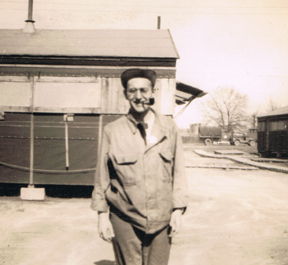During his first decade in Canada, Louis did not marry. While his friend Adrien Sénécal was growing a family, Louis remained single, paying (one presumes) the bachelor tax. In the early 1670s, Louis moved from one settlement to another, but, by the end of the decade, he had become an habitant in Varennes where he would spend the rest of his life.
Louis Ledoux must have constructed at least a simple house for himself and, since one did not grow old alone in these times, for the woman he would sooner or later marry. Often the first farmhouse a man built consisted merely of logs with mud chinked between them. By the late 1670s, it had become customary for the floor not to be simply the ground as had been the custom in France—and in Canada at first—but to be of wood raised above the earth. In Canada, of course, the extreme cold had made earth floors very uncomfortable to live on as the frost settled in the earth and easily radiated through the floor of the structure. To many Europeans in the early days, it must have seemed that, with their earth floors, they were living little better than the “savages.”
It had been necessary for Louis to clear land for a house site and for farming—that is, to remove the maples and the pines and the scrub. These were chopped down by ax. Trees too big to fell by ax were girdled, stripped of a row of bark, and left to die. The clearings, still full of stumps, had to serve as fields. Sometimes, stumps were burned, sometimes they were hacked away and sometimes they were simply left to rot and worked around until they did.
On Sunday, February 19, 1679, before the Montréal notary Maugue, Louis entered into a marriage contract with Marie-Nicole Valiquet. At the time of the wedding contract, the notary Maugue had written of Louis that he was “banished from the Seigneurie of Cap de Varennes.” He also noted that Louis Ledoux had “been living in the said Montréal for eight months.” We have no more details of Louis’ banishment. By the next year, he is living in Varennes again.
How had Louis and Marie meet? Had the encounter occurred while Louis had been living in Montréal for the previous eight months rather than in his landholding in Varennes, and it is possible that it was during this time that he settled on Marie-Nicole Valiquet as the woman who would be his wife. Or, it is possible that he had known of her for a long time and had been waiting for her to grow up? Louis and Marie’s father, Jean Valiquet, were just about the same age, and both came from the same area in France: Louis from Le Mans in Maine and Jean from Le Lude in Anjou, perhaps thirty miles to the south of Le Mans. Marie-Nicole’s mother, Renée Lopée who unfortunately was deceased at the time of the contract signing, was from La Flèche also in Anjou, some ten miles to the northwest of Le Lude. Because of this, the three would have very likely spoken a patois that was quite similar, as might have Marie from growing up in that household. (Most people in New France at this time were fluent in both a regional French patois and in the franca lingua, the official French of government and church[1].
Born in Montréal on December 20, 1662, Marie-Nicole was the oldest of the seven children born to Jean Valiquet and Renée Loppé. Jean was then a widower with a houseful of children. While Marie’s marriage would have meant one person less for the widower to feed, it also took away an oldest daughter who must have served as surrogate mother to her siblings. That task, we can presume, would now fall on fourteen-year-old Elisabeth.
It is hard to imagine Marie-Nicole at sixteen eagerly entering into a marriage with the forty-year-old Louis. In the colony, a man had to be old enough to have launched a viable farm and built a house before he could responsibly marry. A woman, young at the time of her marriage, was likely to be stronger and more able to survive childbirth. For Marie to have married a man her age would have been unthinkable—condemning herself and her children to hunger and want. The age discrepancy between Louis and Marie-Nicole was not uncommon.
For the February 19 contract signing, Louis asked his friend and fellow Varennes farmer Adrien Sénécal (for whose eponymous son Louis had stood as godfather in Trois-Rivières in 1674) to serve as one of his witnesses. Witnesses on Marie’s side included Mathurin Langevin, her father’s cousin. Langevin, who had escaped death at the hands of the Iroquois in 1662, had done well in the colony and had been elected syndic to represent the colonists to the Montréal government.
At the time of the wedding contract, the notary Maugue had written of Louis that he was “banished from the Seigneurie of Cap de Varennes.” He also noted that Louis Ledoux had “been living in the said Montréal for eight months.”[2]
The Sulpician Gilles Perot, married the two on Monday, March 20, at the church of Notre Dame in Montréal. A missionary priest, Perot had celebrated mass for the people of the settlement[3] in the chapel of the Hôtel-Dieu before the parish of Notre Dame of Montréal had been canonically erected the previous October 30 (1678) with Father Perot as its first pastor[4], (Superior also of the Séminaire de Montréal, he was to die suddenly in the seminary yard on July 17, 1680, as he was getting ready to celebrate mass.)
At the nuptial mass, Father Perot would have preached perhaps of the need for the couple to be faithful to each other and to fulfill their responsibility to furnish children for the church and for the colony.
If a merrymaker came to the wedding mass to «nouer l’aiguillette» (tie the cord,) according to stories brought from Medieval France, the couple would not have children. The charm caster would take a cord and make three knots in it. Jean Valiquette and Mathurin Langevin’s cousin Marie Pontonier had been under the curse of the knotted cord, and she and her husband Pierre Gadois had not been been able to conceive children together. When their marriage was annulled and both remarried, they had children with their subsequent spouses. Obviously no one had “tied the knot” at these second wedding celebrations!
[1] That official French became the accent we know as French Canadian. This making uniform of the community’s language did not happen in France for perhaps another three centuries.
[2] We have no more details of Louis’ banishment. By the next year, he is living in Varennes again.
[3] The information on Perot comes from the Dictionary of Canadian Biography. Gilles Perot was the celebrant at the mass at the Hôtel-Dieu on March 25, 1674, when the Sulpician Salignac de La Mothe-Fénelon preached a stinging sermon which Frontenac rightly assumed was aimed at him. Legal proceeding ensued against the Sulpician, leading to Salignac de La Mothe-Fénelon’s removal to France. One did not mess with Frontenac.
[4] The foundation stone for the church building had been laid on June 30, 1672, in the presence of Governor Courcelle and Intendant Talon.



